Get ready to be mesmerized by the celestial beauty of labradorite countertops, where every glance reveals a new kaleidoscope of colors and patterns. This rare gemstone’s extraordinary ability to refract light creates an iridescent glow, making it a showstopper in any kitchen.
With its unique pattern combinations and slab size variations, the design possibilities are endless.
But what makes labradorite truly special? Its natural beauty is backed by fascinating science. When you explore the world of labradorite countertops, you’ll discover the secrets behind its beauty and get insider tips to make your design dreams a reality.
Proper care and maintenance are key to preserving the shine of your labradorite countertops for years to come. With the right approach, you can enjoy the magic of this otherworldly stone without worrying about its durability.
Compared to other natural stones, labradorite stands out for its rarity and unique properties. By understanding its strengths and weaknesses, you can make an informed decision about whether this stone is right for your kitchen.
In this journey, you’ll uncover the intriguing world of labradorite countertops, where science meets beauty and design possibilities are limitless.
Contents
Unique Characteristics of Labradorite
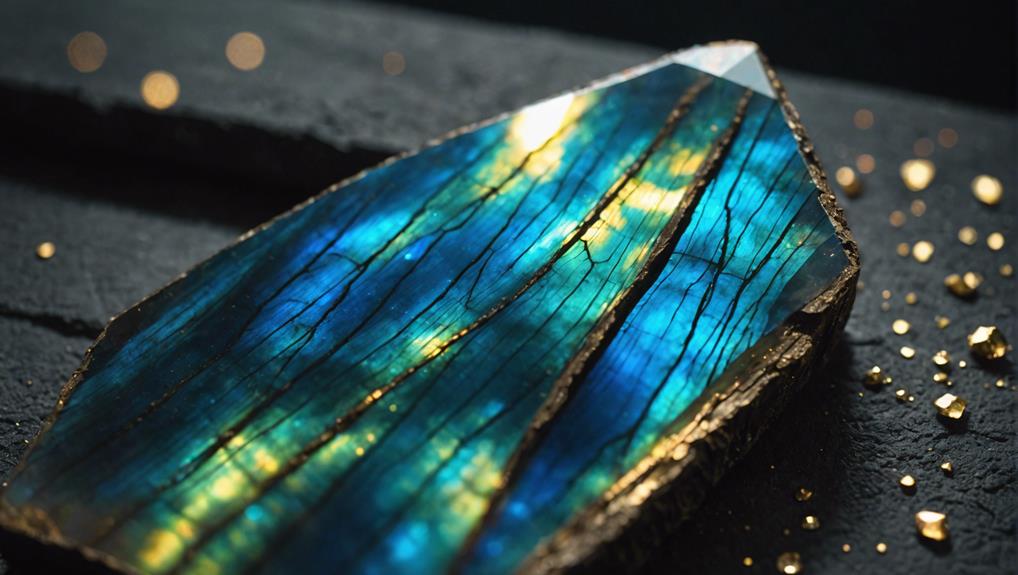
As you explore the world of labradorite countertops, you’ll discover a stone that’s truly one-of-a-kind.
Its unique characteristics set it apart from other natural stones, and you’ll soon find yourself captivated by its mesmerizing features.
From the iridescence that shimmers like the Northern Lights to its rare mineral composition and shimmering color play, labradorite is a true showstopper that’s sure to leave you in awe.
Iridescence in Stone
You’ll notice that labradorite’s iridescence is unlike any other natural stone, thanks to its unique ability to refract light and create an otherworldly glow.
This optical magic happens when light refractions bounce off the stone’s flecks of beauty, producing a shimmer science that’s truly mesmerizing.
As you gaze upon the labradorite, you’ll witness color bursts that seem to emanate from within, as if the gemstone essence is radiating an inner light.
The sparkle secrets behind this phenomenon lie in the way the stone’s crystalline structure interacts with light, creating an ever-changing dance of colors and reflections.
The more you observe labradorite, the more you’ll appreciate the intricate science behind its iridescence.
It’s as if the stone is alive, shifting and adapting to its surroundings to create an ever-new display of color and light.
Whether you’re drawn to the stone’s mystical aura or its sheer aesthetic appeal, labradorite’s iridescence is sure to captivate and inspire.
As you explore the world of labradorite countertops, you’ll discover a dimension of beauty and wonder that’s sure to leave you enchanted.
Rare Mineral Composition
Beyond its mesmerizing iridescence, labradorite’s unique characteristics are rooted in its rare mineral composition, which is primarily made up of sodium, calcium, and aluminum silicates. As you explore further into the world of labradorite, you’ll discover that its mineral structure is characterized by a crystal system that’s typically anorthic, meaning it lacks symmetry. This unique arrangement of minerals gives labradorite its distinct chemical formula: (Ca, Na)₁₂(Al, Si)₄O₈.
| Property | Description |
|---|---|
| Geological Formation | Formed through the slow cooling of magma in igneous rocks |
| Crystal System | Anorthic, lacking symmetry |
| Elemental Analysis | Primarily composed of sodium, calcium, aluminum, silicon, and oxygen |
| Mineralogy Studies | Belongs to the plagioclase feldspar group, a class of minerals known for their earthy origins |
As you venture deeper into the world of labradorite, you’ll find that its rare mineral composition is a result of its geological formation, which involves the slow cooling of magma in igneous rocks. This process allows for the unique arrangement of minerals, resulting in labradorite’s distinct properties. By understanding the intricacies of labradorite’s composition, you’ll appreciate the complexity and beauty of this natural wonder.
Shimmering Color Play
One of labradorite’s most dazzling features is its shimmering color play, which arises from the way light interacts with its unique mineral structure.
As you gaze at the stone, you’ll notice how light reflection creates an optical illusion, making the colors seem to shift and change before your eyes.
This color shift is what gives labradorite its mesmerizing visual interest, adding an extra layer of aesthetic appeal to your countertops.
The way the light dances across the surface, highlighting different hues and tones, is truly enthralling.
It’s no wonder that designers and homeowners alike find labradorite to be a rich source of design inspiration.
The material expression of this stone is unparalleled, offering a one-of-a-kind look that’s sure to elevate any space.
Whether you’re looking to add a touch of sophistication or a dash of drama, labradorite’s shimmering color play is sure to impress.
Design Options and Patterns
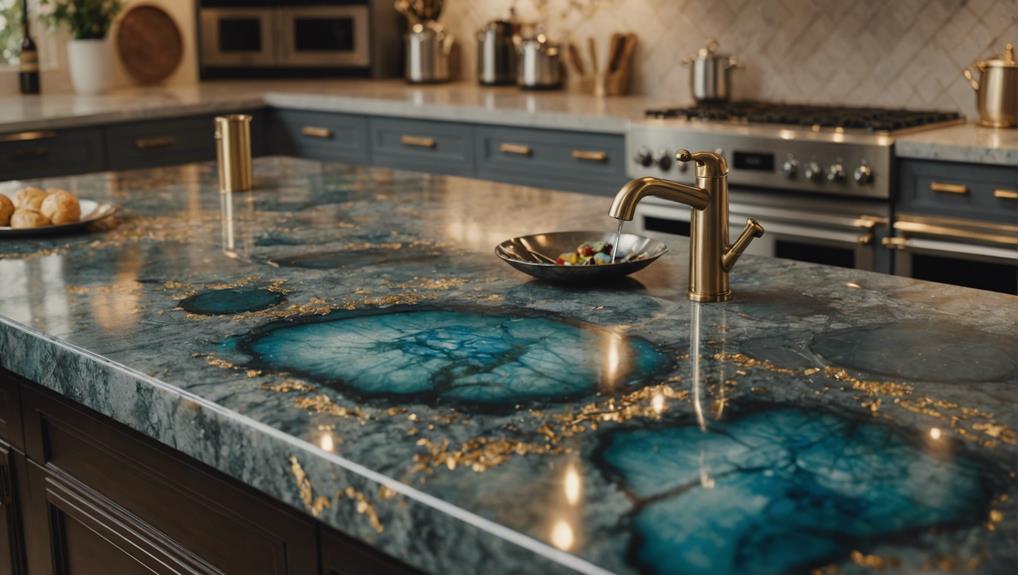
As you start designing your labradorite countertops, you’ll discover a world of possibilities.
You’ll get to choose from unique pattern combinations that showcase the stone’s mesmerizing colors, select a color scheme that complements your kitchen’s aesthetic, and pick an edge profile that adds a touch of sophistication.
With slab size variations and vein pattern emphasis also in the mix, you’ll be able to create a truly one-of-a-kind look that reflects your personal style.
Unique Pattern Combinations
With every slab of labradorite unique, you’ll discover an unparalleled array of pattern combinations that will make your countertops truly one-of-a-kind.
As you explore the vast possibilities, you’ll find that each combination creates a distinct visual identity for your space.
A focal point can be created by combining bold, swirling patterns with more subtle, muted tones, drawing the eye to a specific area of the countertop.
To achieve visual harmony, balance bold patterns with areas of calm, allowing the eye to move seamlessly across the surface.
Labradorite’s natural aesthetic flow can be enhanced through design fusion, blending contrasting patterns and textures to create a cohesive look.
Textural contrast adds depth and interest, while color blocking can be used to create a sense of continuity.
By thoughtfully combining these elements, you can craft a truly bespoke design that reflects your personal style and complements your space.
With labradorite, the possibilities are endless, and the result is a one-of-a-kind masterpiece that’s sure to impress.
Color Scheme Options
You’ll find that labradorite countertops offer a diverse palette of colors, from deep blues and purples to warm golds and oranges, allowing you to select a scheme that perfectly complements your interior design. Whether you’re looking to create a bold statement or a soothing ambiance, labradorite countertops have got you covered.
Here are some popular color scheme options to explore:
| Color Scheme | Description |
|---|---|
| Monochromatic Harmony | Soft pastels and earthy tones blend seamlessly to create a calming atmosphere. |
| Bold Accents | Rich jewels and vibrant oranges add a pop of color to your space. |
| Coastal Vibes | Neutral backgrounds and soft blues evoke the feeling of a seaside retreat. |
From earthy tones to bold accents, labradorite countertops offer a range of options to suit your unique style. Whether you’re going for a coastal vibe or a monochromatic harmony, labradorite countertops will add a touch of sophistication to your space. With its diverse palette, you’ll be able to find the perfect color scheme to match your interior design.
Edge Profile Choices
Selecting the perfect edge profile for your labradorite countertops is just as important as choosing the right color scheme, as it can profoundly impact the overall aesthetic and functionality of your space.
You’ll want to contemplate the style and mood you’re aiming for, as well as the level of maintenance you’re willing to commit to.
Beveled edges, for instance, add a touch of sophistication and can make your countertops appear more slender.
Polished corners, on the other hand, create a seamless look and feel.
If you’re looking to add some visual interest, decorative curves or chamfered ends can do the trick.
Mitered joints are ideal for creating a seamless shift between countertops and walls.
Bullnose profiles and ogee edges offer a more traditional, ornate look.
Whichever edge profile you choose, make sure it complements your labradorite’s natural beauty and enhances the overall flow of your space.
Slab Size Variations
Across various labradorite quarries, slab sizes can vary substantially, offering a range of design options and patterns that can either make or break the visual flow of your space.
As you explore different slabs, you’ll notice that slab widths can range from 3 to 10 feet, and sometimes even larger. However, size limitations and fabrication constraints can impact the availability of certain sizes.
Quarry yields also play a role, as the natural stone’s unique characteristics can affect the size and shape of the slabs extracted.
To overcome these challenges, custom cuts can be made to optimize the slab’s natural beauty. Your fabricator will work with you to select the best slabs and create a layout that minimizes waste and showcases the stone’s unique patterns.
Stock availability can also influence your design choices, so careful planning is crucial and working closely with your supplier is vital.
Vein Pattern Emphasis
As you explore the world of labradorite countertops, the unique vein patterns emerge as a crucial design element, offering a range of visual effects that can elevate or distract from your space’s overall aesthetic.
To make the most of these natural wonders, you’ll want to weigh the vein pattern emphasis in your design. By highlighting the natural accentuation of the veins, you can create a sense of pattern balance, guiding the visual flow of the space.
This, in turn, can create a stunning focal point that draws the eye and adds depth to the room. To achieve design harmony, balancing the bold, contrasting veins with other design elements is crucial, ensuring a cohesive look.
Care and Maintenance Tips
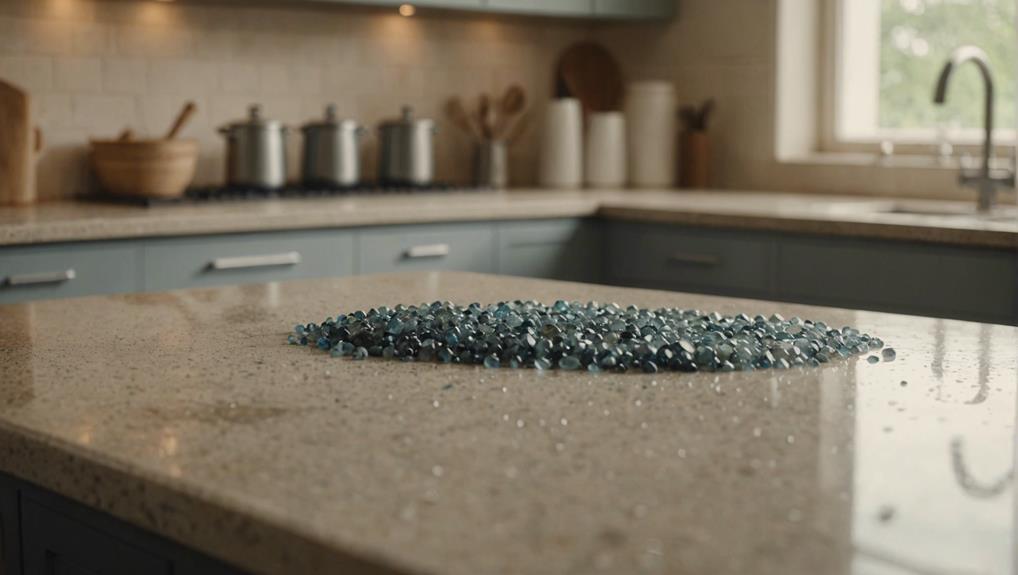
You’ll want to clean your Labradorite countertops regularly to prevent dirt and grime from building up and causing damage. Daily cleaning is a must, and it’s easier than you think. Simply wipe down the surface with a soft cloth and a mild detergent. For tougher stains, mix baking soda and water to create a gentle scrubbing paste. Remember to test any cleaning solution on a small, inconspicuous area first to verify it won’t damage the stone.
To prevent stains, wipe up spills immediately, and consider applying a sealer to protect your countertops from oil-based substances. Labradorite is heat resistant, but it’s still important to use trivets or pot holders to avoid thermal shock. When scrubbing, use gentle circular motions to avoid scratching the surface.
In addition to daily cleaning, make it a habit to inspect your countertops regularly for signs of wear or damage. Check for etching, scratches, or stains, and address them promptly to prevent them from becoming more serious issues. By following these simple care and maintenance tips, you’ll be able to enjoy your beautiful Labradorite countertops for years to come.
Cost and Installation Factors
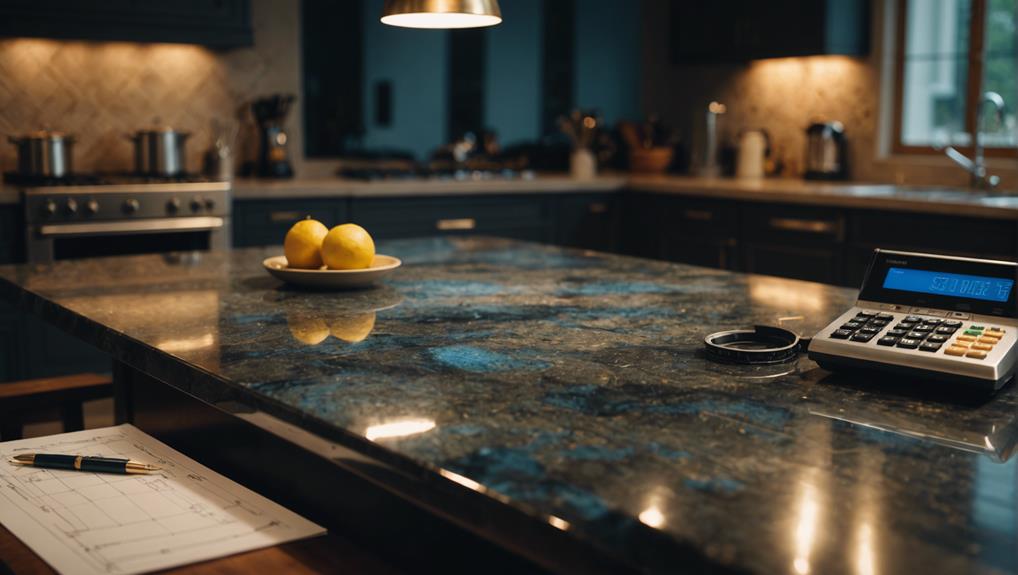
As you consider labradorite countertops for your kitchen or bathroom, you’re probably wondering what the total cost will be.
The price tag is influenced by several factors, including the cost of sourcing the material, the labor fees for installation, and the specific pattern variance you choose.
Material Sourcing Costs
Your material sourcing costs for Labradorite countertops will primarily depend on the quality and availability of the slabs, which can vary substantially based on factors like the quarry’s location and the stone’s rarity.
You’ll need to factor in the supplier contracts, which can affect the price you pay per slab. Additionally, material waste is a significant factor, as it can increase the overall cost.
The environmental impact of quarry operations and transportation costs will also influence the final price. Moreover, export tariffs and mining regulations can add to the expense.
You may find that quarry operations in certain regions have higher environmental standards, leading to increased costs.
Similarly, supplier contracts may include clauses that account for material waste and transportation costs.
Researching and understanding these factors is crucial to get an accurate estimate of your material sourcing costs. By doing so, you’ll be better equipped to make informed decisions about your Labradorite countertop project.
Labor Installation Fees
The labor installation fees for your Labradorite countertops are largely determined by the complexity of the installation, the installer’s level of expertise, and the region in which you’re located. As you plan your project, it’s essential to understand the factors that influence labor costs.
The longer the installation takes, the higher the labor costs. A more complex design or larger countertop area will require more time and expertise, increasing the fee. This is because installation timeline plays a significant role in determining labor costs.
Installers may charge by the hour, by the square foot, or as a flat rate for the entire project. Be sure to ask about their fee structure and what’s included in the quote. This is another crucial factor to consider when estimating labor costs.
An experienced installer with proper insurance coverage will typically charge more than a less-experienced worker. However, their expertise and protection will give you peace of mind and ensure a high-quality installation. Worker experience and insurance are also important considerations.
Additionally, permit requirements, labor laws, and regional regulations can impact labor costs. It’s crucial to discuss these details with your installer to get an accurate estimate for your Labradorite countertop installation.
Pattern Variance Pricing
You’ll also need to factor in the cost implications of pattern variance in your Labradorite countertops, which can substantially impact the overall price of your project.
The unique patterns and colors of Labradorite slabs can affect their pricing, making it essential to think about these factors when budgeting for your project.
Market fluctuations, regional pricing, and material grading all play a role in determining the cost of your countertops.
Additionally, slab sourcing, fabrication costs, and wholesale discounts can also influence the final price.
For instance, if you’re looking for a specific pattern or color, you may need to pay a premium.
On the other hand, if you’re flexible with your design, you might be able to take advantage of seasonal demand and score a better deal.
It’s vital to work with a reputable supplier or fabricator who can guide you through the process and help you navigate these complexities.
Popular Alternatives and Comparisons
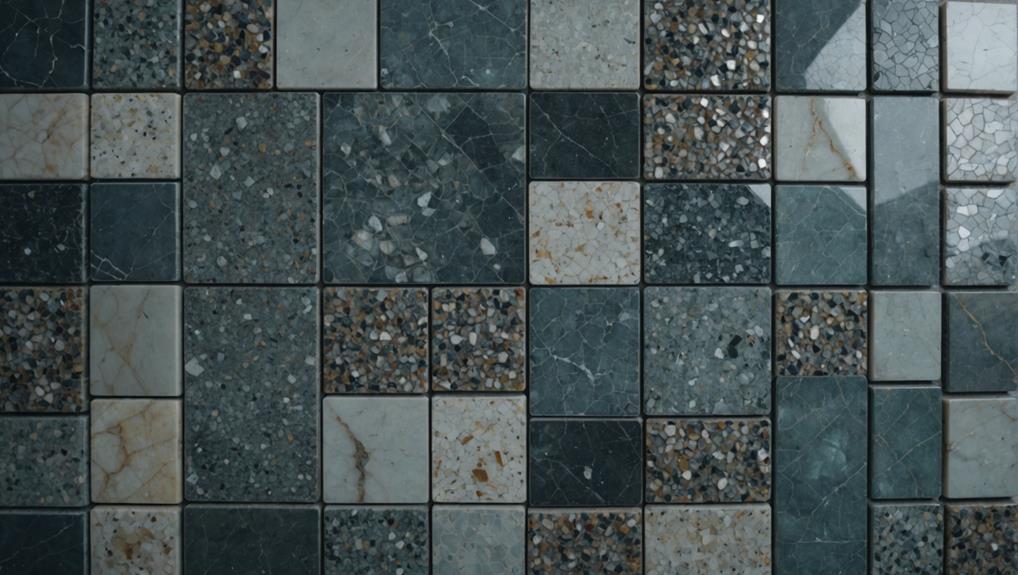
As you weigh the pros and cons of labradorite countertops, you’re likely wondering how they stack up against other popular options.
You might be considering granite, for instance, which offers a similar durability but distinct aesthetic.
Let’s explore how labradorite compares to other stones, like marble and soapstone, as well as quartz and schist, to find the perfect fit for your design vision.
Granite Vs Labradorite
By now, you’re likely considering granite and labradorite as top contenders for your dream countertops, but which one will reign supreme in your kitchen or bath renovation?
Both options boast unique characteristics that set them apart from other materials. Let’s explore the key differences to help you make an informed decision.
Aesthetic Appeal
Labradorite’s iridescent play of colors, known as labradorescence, adds an extra layer of visual interest to its natural beauty. Granite, on the other hand, offers a more subtle, speckled pattern.
Durability Tests
Both materials are incredibly durable, but granite takes the lead in scratch resistance. Labradorite, however, is more resistant to heat damage, surpassing granite in this regard.
Cost Comparisons
Granite tends to be more budget-friendly, especially for larger installations. Labradorite’s unique characteristics come at a higher cost, but its rarity and historical significance may justify the extra expense.
When considering installation methods, environmental impact, and overall value, weigh these factors against your personal preferences and priorities. Will you opt for the timeless charm of granite or the mesmerizing beauty of labradorite?
Marble Alternatives Exist
While marble’s timeless elegance is undeniable, its high maintenance requirements and susceptibility to etching often lead homeowners to explore alternative options that mimic its luxurious appeal.
You’re not alone in seeking a material that captures marble’s natural beauty without the hefty price tag and upkeep. Fortunately, several alternatives exist that offer a similar aesthetic appeal without the drawbacks.
As a budget-conscious homeowner, you might consider eco-friendly options like recycled glass or porcelain countertops.
These sustainable options not only reduce waste but also provide a luxury feel at a lower cost.
If design freedom is essential to you, engineered stone or concrete countertops can be customized to fit your unique style.
Additionally, these materials are more resistant to etching and staining, making them a practical choice.
Labradorite, with its iridescent play of colors, is another stunning alternative that offers a unique blend of natural beauty and durability.
Quartz Countertop Options
What makes quartz countertops a popular alternative to marble, and how do they compare to other options like labradorite and engineered stone? You might be wondering what sets quartz apart from its competitors. The answer lies in its unique combination of benefits.
Quartz is known for its exceptional durability and resistance to scratches, heat, and stains, making it an ideal choice for busy kitchens.
With a wide range of colors and patterns to choose from, quartz countertops can mimic the look of natural stone or offer a unique aesthetic that’s all its own.
Quartz surfaces are non-porous, easy to clean, and can be customized to fit your design style, from modern to traditional.
When it comes to installation methods, material choices, and design flexibility, quartz countertops offer a high level of versatility. They can be installed using various methods, including slab installation and tile installation, and can be paired with a range of materials, such as cabinets, backsplashes, and flooring.
With quartz, you can create a unique look that reflects your personal style and complements your home’s décor.
Soapstone Similarities Found
You may find that labradorite countertops, like soapstone, offer a unique, natural aesthetic that sets them apart from quartz and other engineered stone options.
Both materials share a soapstone aesthetic, characterized by a fossilized look that adds depth and visual interest to your kitchen.
The earthy tone of labradorite countertops is reminiscent of soapstone, with its soft pattern and subtle variations in color.
One of the standout features of both materials is their natural beauty, which only improves with time.
As they develop a gentle patina, they exude a timeless charm that’s hard to resist.
In terms of finish, both labradorite and soapstone tend to have a matte finish, which helps to hide fingerprints and smudges.
This makes them a practical choice for busy kitchens.
While they may require more maintenance than other materials, the payoff is well worth it.
With their unique blend of natural beauty and understated elegance, labradorite and soapstone countertops are sure to become the centerpiece of your kitchen.
Schist Countertop Lookalikes
Look to schist-inspired alternatives to capture the essence of labradorite countertops without the hefty price tag, as these lookalikes offer a similar blend of earthy tones and subtle patterns. You’ll find that schist options can mimic the natural beauty of labradorite, but at a fraction of the cost.
If you’re looking for alternative materials that evoke the same aesthetic, consider the following:
- Faux finishes: These decorative surfaces can be designed to replicate the iridescent sheen and earthy hues of labradorite, making them a budget-friendly alternative.
- Natural replicas: Stone mimics can be crafted to resemble labradorite’s unique patterns and colors, offering a more affordable option without sacrificing style.
- Budget alternatives: Explore schist-inspired materials that offer a similar look and feel to labradorite, but at a lower cost.
These schist countertop lookalikes can provide you with a similar style and aesthetic to labradorite, without breaking the bank. By opting for alternative materials or natural replicas, you can achieve the look you want without compromising on budget.
Frequently Asked Questions
Can Labradorite Countertops Be Used in Outdoor Kitchens?
When considering outdoor kitchens, you wonder if certain surfaces can withstand the elements.
The question is, can they handle outdoor durability and weather resistance?
Will sunlight effects cause fading or discoloration?
How about moisture absorption and prolonged exposure to the elements?
If you want to maintain natural beauty and exterior aesthetics, you need a material that can keep up.
Are Labradorite Countertops Resistant to Heat Damage?
When it comes to heat damage, you’re right to wonder if your countertops can handle the heat.
In material science, thermal resistance is key to preventing damage.
Countertop testing reveals that some materials can withstand thermal shock, while others can’t.
To prevent damage, it’s vital to understand a material’s heat tolerance and heat absorption rates.
Can I Place Hot Pans Directly on Labradorite Surfaces?
When you’re cooking up a storm, it’s tempting to place hot pans directly on your countertops.
But be cautious! Thermal shock can occur when extreme heat meets a cooler surface, causing damage.
For heat protection, it’s best to use a trivet or pot holder to create a barrier between the pan and surface.
This guarantees surface durability and cooking safety, making daily usage and countertop maintenance a breeze.
Does Labradorite Contain Any Toxic or Hazardous Materials?
You’re wondering if the materials you bring into your home are safe.
That’s a great question!
When it comes to toxic or hazardous materials, you’ll be relieved to know that labradorite is generally considered eco-friendly.
Its mineral makeup is naturally occurring, with a chemical composition that doesn’t pose significant health risks.
Radon emissions are also negligible, and its environmental impact is minimal.
Can Labradorite Countertops Be Recycled or Repurposed?
You’re probably wondering if that beautiful slab of stone can be recycled or repurposed when its countertop days are over.
The good news is, yes, many materials can be recycled or reused, reducing waste and supporting sustainable living.
In material science, understanding the recycling process is key to minimizing environmental impact.
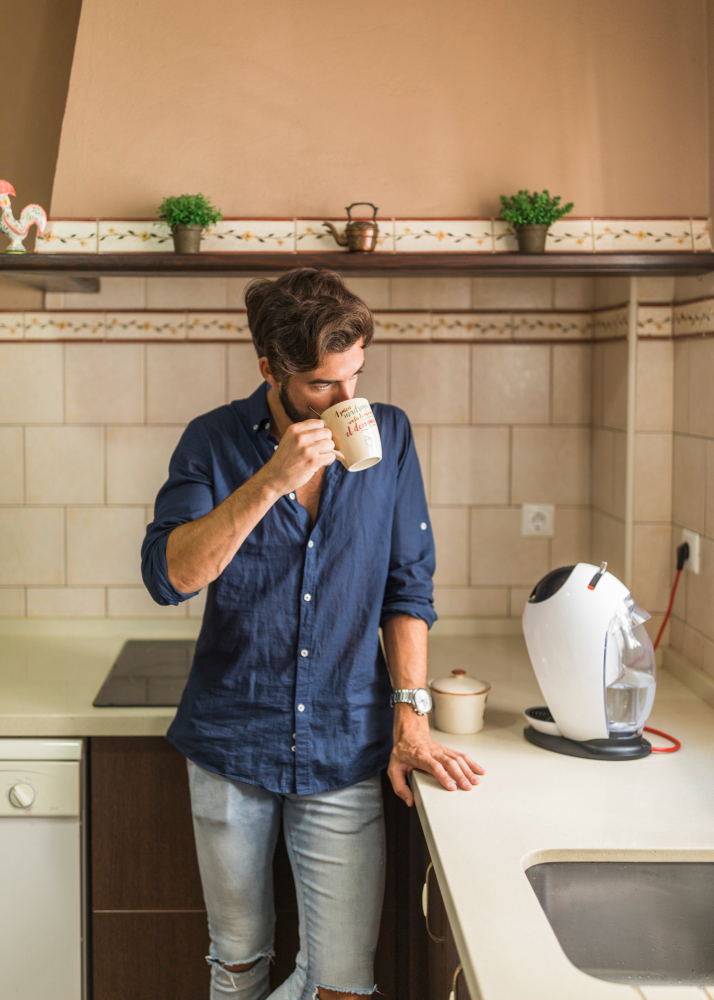
Jimmy Dean is a dedicated freelance writer who specializes in the home improvement sector. His passion for beautifying homes has been a lifelong pursuit. His expertise lies in the areas of cleaning, organizing, and executing home improvement projects. He uses his knowledge and skills to transform living spaces into aesthetically pleasing and functional homes.